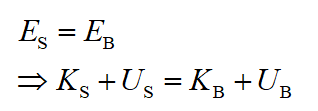
Concept explainers
I performed a lab using a toy car to go down a ramp that was positioned at different heights. For expample: ramp height = 40 cm, ramp length = 121.92 cm, time car took to clear the ramp from start = .86 seconds, distance car traveled from end of ramp to stopping point = 937.26 cm, mass of car = .54 kg, based off this information.....
Calculate the velocity of the car at the end of the ramp just before it starts its horizontal path to its stopping point. PE = KE = (1/2) m v^2
As per the conservation law of energy,

Here, E, K, and U represent the car’s total energy, the car’s kinetic energy, and the car’s potential energy, respectively.
Here, the subscript S and B represent the car’s position at the ramp’s top and ramp’s bottom, respectively.
The car’s kinetic energy can be represented as,

Here, m and v represent the car’s mass and the car’s velocity, respectively.
The car’s potential energy can be represented as,

Here h represents the car’s height from the ramp’s bottom.
Step by stepSolved in 2 steps with 5 images

- This is one-dimensional. This part uses pure numbers, dispensing with units. If a ball's acceleration is -4, and its initial velocity is 7, derive v(t) -- velocity as a function of time. Now use parameters a and v0, and derive v(t).arrow_forwardAn astronaut chillin’ on the moon drops her bag of Takis (doh!). g on the moon is 1.6 m/s/s. The Takis fell for 1.23 seconds. (a) How far did they fall? (b) What was their final velocity?arrow_forwardConsider the 4 sets of data shown below for v(t) the velocity of an object in freefall with the corresponding linear curve fits. The slope of the best fit line gives the acceleration, and for comparison a dashed line with a slope of -g is shown. BANJA $ (A) (C) (0) 5 0 BUMBA . (B) (D) Figure 1.1: Example data 1. Which data set, or sets has the best accuracy? 100 2. Which data set or sets has the best precision? e balt mp 50c 1-100 C 9/10 tabarrow_forward
- I need steps to solve this in order to understandarrow_forwardAn unwary football player collides head-on with a padded goalpost while running at 7.2 m/s and comes to a full stop after compressing the padding and his body by 0.28 m. Take the direction of the player’s initial velocity as positive Assuming constant acceleration, calculate his acceleration during the collision, in meters per second squared. How long does the collision last in seconds?arrow_forwardA cyclist accelerates at a constant rate of 2.88 m/s2 for 2.82 s. If their final velocity is 12.6 m/s, what was their initial velocity? Give your answer in m/s to 2 decimal places, but do not include units in your answer.arrow_forward
- The jet car is originally traveling at a velocity of 10 m/s when it is subjected to the acceleration shown. When -0.s=0 Supposie that a, =45 m/s. a=35 m/s and t"= 12 s. (Flgure 1) Determine the car's maximum velocity Express your answer to three significant figures and include the appropriate units. Value Units Figure <1 of 1 Submit RenstAnnwer e (m/) Part B Detemine he timo t when the car stops Express your answer to three significant figures and include the appropriate units. t's Value Unts Submit BesustAnswearrow_forwardHigh-speed motion pictures (3500 frames/second) of a jumping 230 μg flea yielded the data to plot the flea's acceleration as a function of time as shown in the figure ( Figure 1). (See "The Flying Leap of the Flea," by M. Rothschild et al. in the November 1973 Scientific American.) This flea was about 2 mm long and jumped at a nearly vertical takeoff angle. Use the measurements shown on the graph to answer the questions. Figure alg 150 100 50 0 0 0.5 1.0 1.5 Part E Use the graph to find the flea's maximum speed. Express your answer in meters per second to two significant figures. IVE] ΑΣΦ 3 v=1.6 Submit Previous Answers Request Answer ? X Incorrect; Try Again; 2 attempts remaining m/sarrow_forwardWhen you drive to work on a winding road, the odometer of your car changes from 27120 km to 27140 km in 30 minutes. The car's average speed was exactly 40 km/hr. The magitude of the car's average velocity was: -more than 40 km/hr or -less than 40 knm/hrarrow_forward
 College PhysicsPhysicsISBN:9781305952300Author:Raymond A. Serway, Chris VuillePublisher:Cengage Learning
College PhysicsPhysicsISBN:9781305952300Author:Raymond A. Serway, Chris VuillePublisher:Cengage Learning University Physics (14th Edition)PhysicsISBN:9780133969290Author:Hugh D. Young, Roger A. FreedmanPublisher:PEARSON
University Physics (14th Edition)PhysicsISBN:9780133969290Author:Hugh D. Young, Roger A. FreedmanPublisher:PEARSON Introduction To Quantum MechanicsPhysicsISBN:9781107189638Author:Griffiths, David J., Schroeter, Darrell F.Publisher:Cambridge University Press
Introduction To Quantum MechanicsPhysicsISBN:9781107189638Author:Griffiths, David J., Schroeter, Darrell F.Publisher:Cambridge University Press Physics for Scientists and EngineersPhysicsISBN:9781337553278Author:Raymond A. Serway, John W. JewettPublisher:Cengage Learning
Physics for Scientists and EngineersPhysicsISBN:9781337553278Author:Raymond A. Serway, John W. JewettPublisher:Cengage Learning Lecture- Tutorials for Introductory AstronomyPhysicsISBN:9780321820464Author:Edward E. Prather, Tim P. Slater, Jeff P. Adams, Gina BrissendenPublisher:Addison-Wesley
Lecture- Tutorials for Introductory AstronomyPhysicsISBN:9780321820464Author:Edward E. Prather, Tim P. Slater, Jeff P. Adams, Gina BrissendenPublisher:Addison-Wesley College Physics: A Strategic Approach (4th Editio...PhysicsISBN:9780134609034Author:Randall D. Knight (Professor Emeritus), Brian Jones, Stuart FieldPublisher:PEARSON
College Physics: A Strategic Approach (4th Editio...PhysicsISBN:9780134609034Author:Randall D. Knight (Professor Emeritus), Brian Jones, Stuart FieldPublisher:PEARSON





